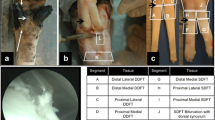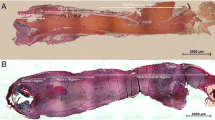Abstract
Background
We have recently reported that interpositional synovium grafts from tendon sheath have a potential to accelerate tendon healing when implanted at the repair site. The purpose of this study was to investigate the effect of orientation of the synovium after synovium graft transplantation, by comparing the ability of cells from the visceral and parietal surfaces to migrate into the tendon in a canine tissue culture model.
Methods
The synovium graft was placed within a complete tendon laceration, with either the visceral or parietal surface facing the proximal end of the lacerated tendon. The number of migrating cells was quantified by a cell migration assay. Qualitative immunohistochemistry and confocal laser microscopy were also used at day 10.
Results
Many labeled synovial cells were observed within the tendon to which the visceral surface of the synovium graft was facing. Migrated cells were also observed on the parietal side, but there were fewer cells compared to visceral surface cells. Migrating cells all expressed α-smooth muscle actin.
Conclusion
We found that graft orientation affected cell migration. Whether this finding has clinical significance awaits in vivo study.





Similar content being viewed by others
References
Amadio PC, Hunter JM, Jaeger SH, et al. The effect of vincular injury on the results of flexor tendon surgery in zone 2. J Hand Surg Am. 1985;10:626–32.
Amiel D, Frank C, Harwood F, et al. Tendons and ligaments: a morphological and biochemical comparison. J Orthop Res. 1984;1:257–65.
Aspenberg P, Forslund C. Enhanced tendon healing with GDF 5 and 6. Acta Orthop Scand. 1999;70:51–4.
Beredjiklian PK. Biologic aspects of flexor tendon laceration and repair. J Bone Joint Surg Am. 2003;85-A:539–50.
Brockis JG. The blood supply of the flexor and extensor tendons of the fingers in man. J Bone Joint Surg Br. 1953;35-B:131–8.
Chang J, Most D, Thunder R, et al. Molecular studies in flexor tendon wound healing: the role of basic fibroblast growth factor gene expression. J Hand Surg Am. 1998;23:1052–8.
Costa MA, Wu C, Pham BV, et al. Tissue engineering of flexor tendons: optimization of tenocyte proliferation using growth factor supplementation. Tissue Eng. 2006;12:1937–43.
Dykyj D, Jules KT. The clinical anatomy of tendons. J Am Podiatr Med Assoc. 1991;81:358–65.
Gelberman RH. Flexor tendon physiology: tendon nutrition and cellular activity in injury and repair. Instr Course Lect. 1985;34:351–60.
Gelberman RH, Vande Berg JS, Lundborg GN, et al. Flexor tendon healing and restoration of the gliding surface. An ultrastructural study in dogs. J Bone Joint Surg Am. 1983;65:70–80.
Giurea A, Ruger BM, Hollemann D, et al. STRO-1+ mesenchymal precursor cells located in synovial surface projections of patients with osteoarthritis. Osteoarthritis Cartilage. 2006;14:938–43.
Hinz B, Phan SH, Thannickal VJ, et al. The myofibroblast: one function, multiple origins. Am J Pathol. 2007;170:1807–16.
Ikeda J, Zhao C, Moran SL, et al. Effects of synovial interposition on healing in a canine tendon explant culture model. J Hand Surg Am. 2010;35:1153–9.
Ippolito E, Natali PG, Postacchini F, et al. Morphological, immunochemical, and biochemical study of rabbit Achilles tendon at various ages. J Bone Joint Surg Am. 1980;62:583–98.
Ippolito E, Natali PG, Postacchini F, et al. Ultrastructural and immunochemical evidence of actin in the tendon cells. Clin Orthop Relat Res. 1977;126:282–4.
James R, Kesturu G, Balian G, et al. Tendon: biology, biomechanics, repair, growth factors, and evolving treatment options. J Hand Surg Am. 2008;33:102–12.
Jones ME, Mudera V, Brown RA, et al. The early surface cell response to flexor tendon injury. J Hand Surg Am. 2003;28:221–30.
Juncosa-Melvin N, Boivin GP, Gooch C, et al. The effect of autologous mesenchymal stem cells on the biomechanics and histology of gel-collagen sponge constructs used for rabbit patellar tendon repair. Tissue Eng. 2006;12:369–79.
Khan U, Edwards JC, McGrouther DA. Patterns of cellular activation after tendon injury. J Hand Surg Br. 1996;21:813–20.
Khan U, Occleston NL, Khaw PT, et al. Differences in proliferative rate and collagen lattice contraction between endotenon and synovial fibroblasts. J Hand Surg Am. 1998;23:266–73.
Kleinert HE, Schepel S, Gill T. Flexor tendon injuries. Surg Clin North Am. 1981;61:267–86.
Lundborg G. Experimental flexor tendon healing without adhesion formation--a new concept of tendon nutrition and intrinsic healing mechanisms. A preliminary report. Hand. 1976;8:235–8.
Luo J, Mass DP, Phillips CS, et al. The future of flexor tendon surgery. Hand Clin. 2005;21:267–73.
Manske PR, Lesker PA, Gelberman RH, et al. Intrinsic restoration of the flexor tendon surface in the nonhuman primate. J Hand Surg Am. 1985;10:632–7.
Mattey DL, Dawes PT, Nixon NB, et al. Transforming growth factor beta 1 and interleukin 4 induced alpha smooth muscle actin expression and myofibroblast-like differentiation in human synovial fibroblasts in vitro: modulation by basic fibroblast growth factor. Ann Rheum Dis. 1997;56:426–31.
Murray MM, Spector M. Fibroblast distribution in the anteromedial bundle of the human anterior cruciate ligament: the presence of alpha-smooth muscle actin-positive cells. J Orthop Res. 1999;17:18–27.
Postlethwaite AE, Seyer JM, Kang AH. Chemotactic attraction of human fibroblasts to type I, II, and III collagens and collagen-derived peptides. Proc Natl Acad Sci U S A. 1978;75:871–5.
Potenza AD. Prevention of adhesions to healing digital flexor tendons. JAMA. 1964;187:187–91.
Ragoowansi R, Khan U, Brown RA, et al. Differences in morphology, cytoskeletal architecture and protease production between zone II tendon and synovial fibroblasts in vitro. J Hand Surg Br. 2003;28:465–70.
Rickert M, Wang H, Wieloch P, et al. Adenovirus-mediated gene transfer of growth and differentiation factor-5 into tenocytes and the healing rat Achilles tendon. Connect Tissue Res. 2005;46:175–83.
Ritty TM, Roth R, Heuser JE. Tendon cell array isolation reveals a previously unknown fibrillin-2-containing macromolecular assembly. Structure. 2003;11:1179–88.
Skoog T, Persson BH. An experimental study of the early healing of tendons. Plast Reconstr Surg (1946). 1954;13:384–99.
Smith JW. Blood supply of tendons. Am J Surg. 1965;109:272–6.
Strickland JW. Development of flexor tendon surgery: twenty-five years of progress. J Hand Surg Am. 2000;25:214–35.
Tang JB, Xu Y, Ding F, et al. Tendon healing in vitro: promotion of collagen gene expression by bFGF with NF-kappaB gene activation. J Hand Surg Am. 2003;28:215–20.
Thomopoulos S, Zaegel M, Das R, et al. PDGF-BB released in tendon repair using a novel delivery system promotes cell proliferation and collagen remodeling. J Orthop Res. 2007;25:1358–68.
Tozer S, Duprez D. Tendon and ligament: development, repair and disease. Birth Defects Res C Embryo Today. 2005;75:226–36.
Wang XT, Liu PY, Tang JB. Tendon healing in vitro: modification of tenocytes with exogenous vascular endothelial growth factor gene increases expression of transforming growth factor beta but minimally affects expression of collagen genes. J Hand Surg Am. 2005;30:222–9.
Winters SC, Gelberman RH, Woo SL, et al. The effects of multiple-strand suture methods on the strength and excursion of repaired intrasynovial flexor tendons: a biomechanical study in dogs. J Hand Surg Am. 1998;23:97–104.
Winters SC, Seiler 3rd JG. Woo SL, et al. Suture methods for flexor tendon repair. A biomechanical analysis during the first six weeks following repair. Ann Chir Main Memb Super. 1997;16:229–34.
Wong J, Bennett W, Ferguson MW, et al. Microscopic and histological examination of the mouse hindpaw digit and flexor tendon arrangement with 3D reconstruction. J Anat. 2006;209:533–45.
Acknowledgments
This study was supported by grants from NIH (NIAMS) AR44391 and Mayo Foundation.
Conflicts of Interest
The authors declare they have no conflict of interest.
Author information
Authors and Affiliations
Corresponding author
About this article
Cite this article
Hayashi, M., Zhao, C., An, KN. et al. Cell migration after synovium graft interposition at tendon repair site. HAND 7, 374–379 (2012). https://doi.org/10.1007/s11552-012-9453-x
Published:
Issue Date:
DOI: https://doi.org/10.1007/s11552-012-9453-x




